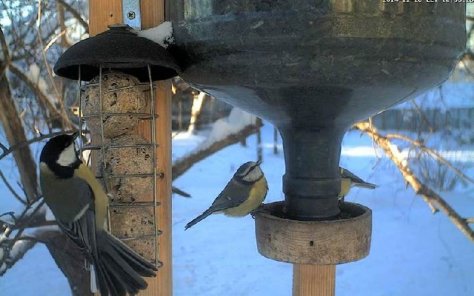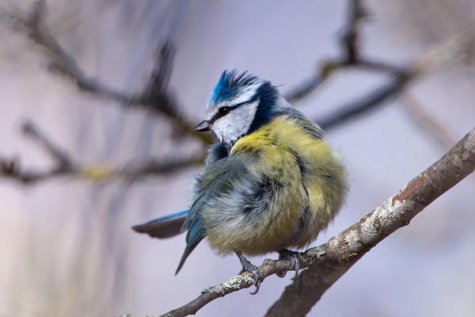Winter bird feeder camera - Blue tit
Image from webcam captured by IceAge
Photo Arne Ader
Translation Liis
Blue tit Sinitihane Parus caeruleus
In the morning dusk, just after the visit of the first great tits at the feeder, the slightly more cautious and shy blue tits are in place – they quickly snatch a sunflower seed and the bird is gone. Depending on the situation the little blue tits can behave quite shrewishly to fight for a place at the food table; larger but slower birds realise the need to fear the little sharp beak and piercing claws.
Blue tits are about an inch smaller than great tits (these are our largest tits), or less than about 12 centimetres; weighing a little over 10 grams but large great tit males weigh more than twenty grams.
In winter they feed on seeds, but pick with pleasure at fat balls; “tit bells” are made even today for our winged friends (rolled oats mixed with unsalted fat), in places lard is offered and they are happily busy at the high-calorie food during the cold and short winter days.
Winterers are mostly adult birds or a pair that nested together in the summer (if they have had the luck to avoid all hazards). In some years the migration urge can bring most of the birds that hatched in summer to Central or Western Europe. We estimate the winter number at slightly over 150 000 individuals. Thanks to bird friends that care for tits and other wintering passerines the number has not decreased.
Both sexes have similar plumages. The neck of the tiny blue tits is unvisible – the round head is as if planted on the body. On the yellow chest there is no black band, characteristic of the great tit, only a darker little streak. The sky blue top of the head that male birds sometimes fluff up is surrounded by a white circle, the bulging cheeks shining white. A narrow black mask covers the dark brown eyes, little black beak and area under the chin. The band at the nape is dark blue as the collar that widens at the neck.
In a nice light the back plumage shimmers in green, wings and tail in blue. White wing bands similar to the great tit. The tiny legs are greyish-blue.
Blue tit observations: LINK
Blue tit
Only the males sometimes fluff up the blue feathers on the crown










